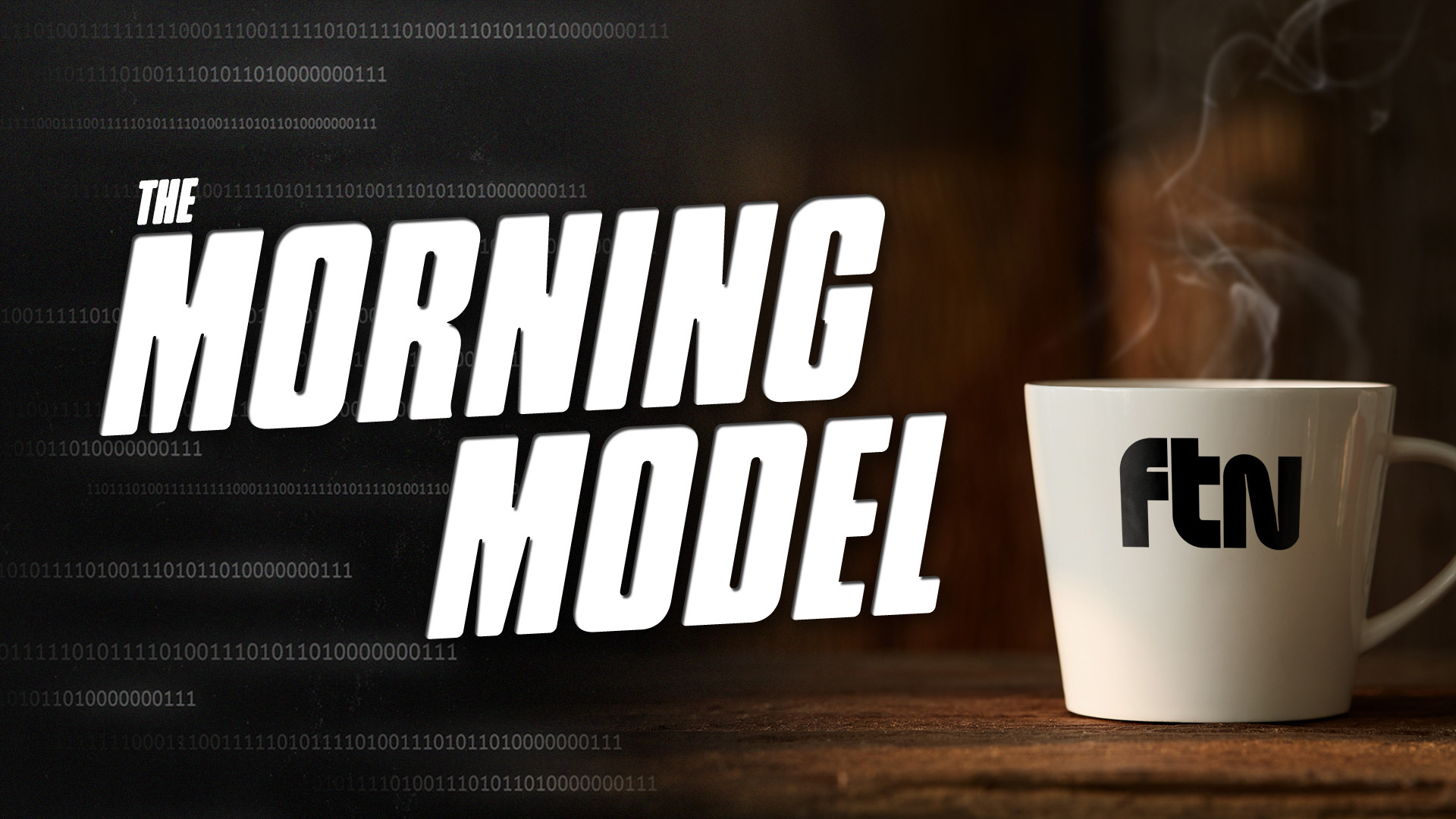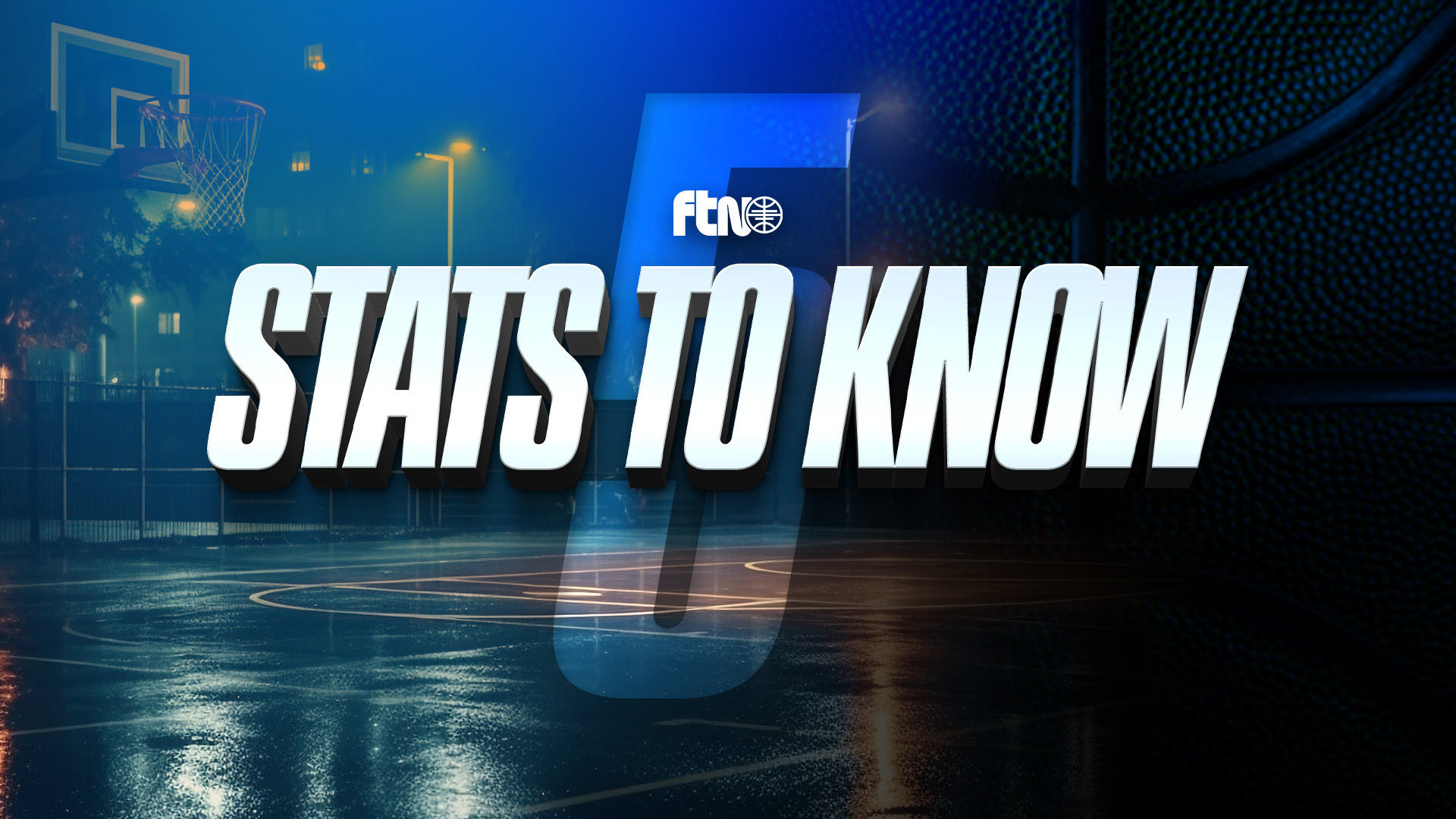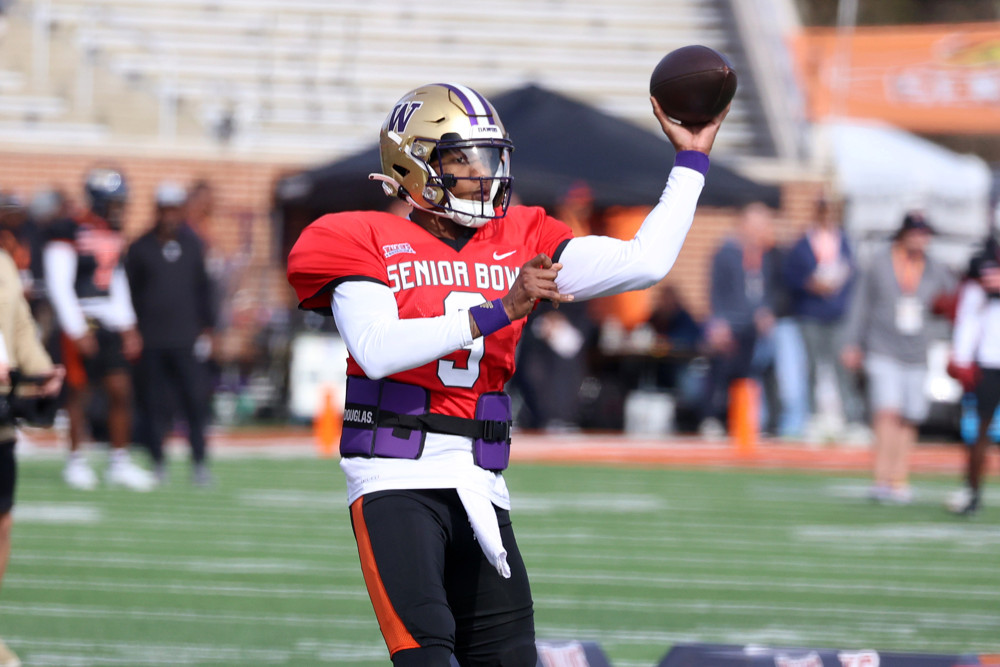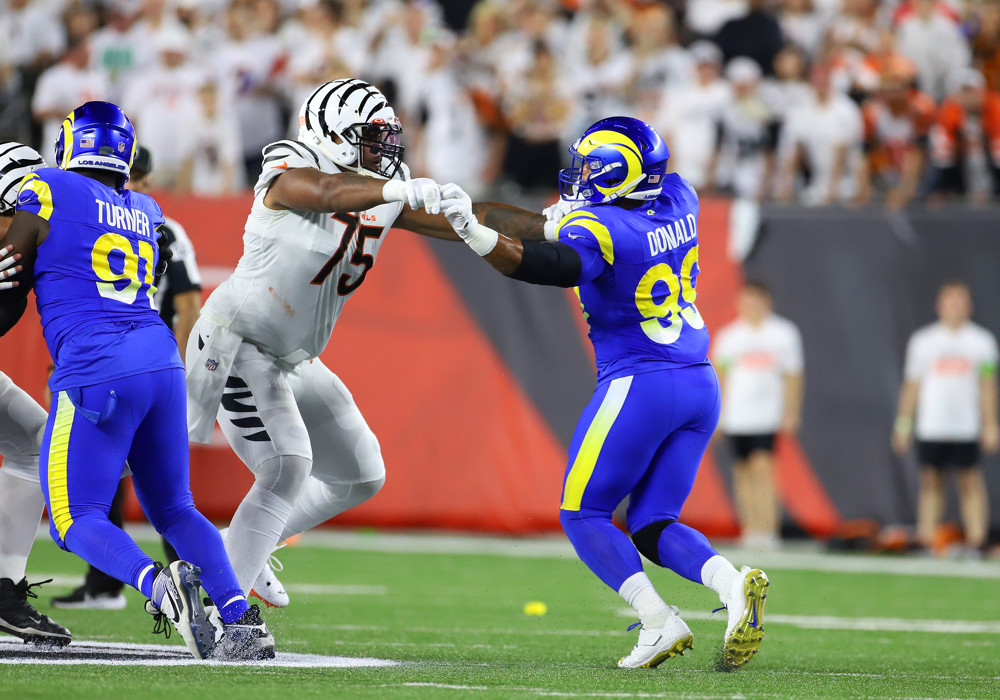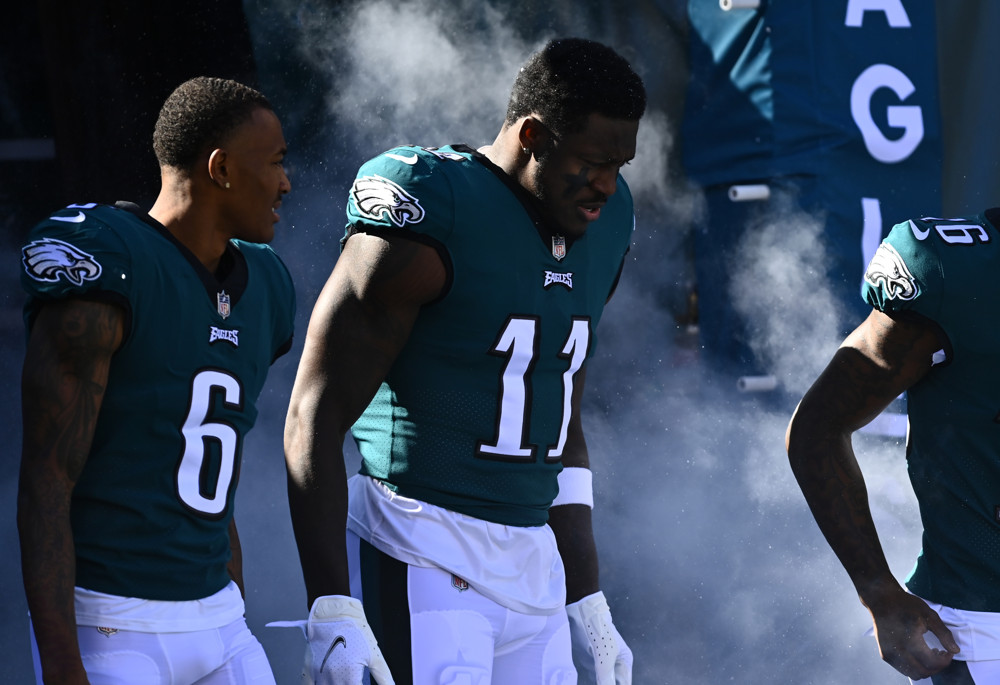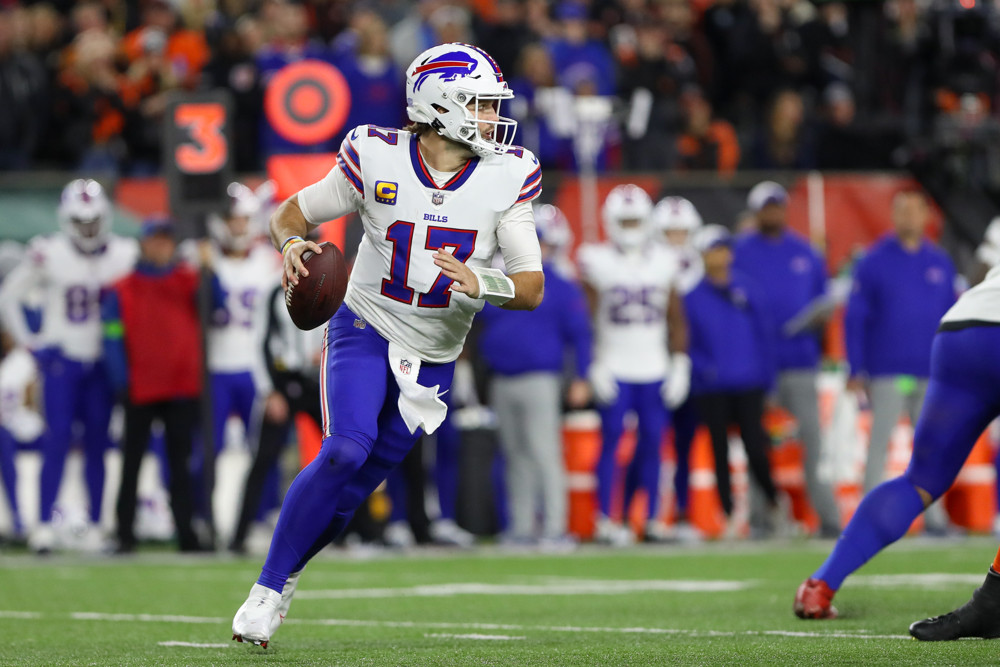
Yesterday, we took a look at snap-weighted size for offenses in 2023. Today, we’ll take a look at defenses, special teams, and then total numbers.
It should be noted that this is more of a descriptive stat than anything prescriptive. We have consistently found that height has almost no correlation with DVOA, even if you only look at wide receivers or cornerbacks in the passing game. It’s not that height doesn’t matter at all; it’s more that there’s so little variance in height that having an inch or two advantage over the other team gets lost among all the other nuances of playing the position. Weight does make more of an impact, but the correlations are still fairly low across the board. For instance, teams with bigger linemen, on either side of the ball, tend to be better in the run game and worse in the passing game, but there’s not a super-strong correlation between any of this and actual on-field success. If anything, the correlations were weaker in 2023 than they were in previous seasons.
| Defensive Snap-Weighted Size, 2023 | ||||||
| Team | Height | Rk | Weight | Rk | BMI | Rk |
| BAL | 73.6 | 21 | 244.7 | 1 | 31.6 | 1 |
| NE | 73.7 | 20 | 244.2 | 2 | 31.4 | 2 |
| GB | 73.8 | 14 | 242.0 | 3 | 31.1 | 4 |
| TB | 73.5 | 26 | 240.2 | 4 | 31.2 | 3 |
| CHI | 73.9 | 11 | 239.9 | 5 | 30.8 | 9 |
| NYG | 74.2 | 1 | 239.6 | 6 | 30.4 | 20 |
| MIA | 74.1 | 4 | 239.6 | 7 | 30.5 | 17 |
| CIN | 73.6 | 24 | 239.6 | 8 | 30.9 | 6 |
| DET | 74.0 | 9 | 239.4 | 9 | 30.7 | 11 |
| LAC | 73.5 | 25 | 238.9 | 10 | 30.8 | 7 |
| NO | 73.8 | 12 | 238.7 | 11 | 30.6 | 12 |
| PHI | 73.6 | 23 | 237.9 | 12 | 30.7 | 10 |
| CAR | 73.8 | 13 | 237.4 | 13 | 30.4 | 19 |
| JAX | 74.0 | 5 | 236.9 | 14 | 30.2 | 26 |
| LAR | 73.6 | 22 | 236.7 | 15 | 30.6 | 14 |
| WAS | 74.2 | 2 | 236.7 | 16 | 30.1 | 27 |
| Team | Height | Rk | Weight | Rk | BMI | Rk |
| KC | 73.7 | 19 | 236.7 | 17 | 30.5 | 15 |
| CLE | 73.7 | 18 | 236.4 | 18 | 30.4 | 18 |
| SF | 73.7 | 17 | 236.0 | 19 | 30.4 | 21 |
| DEN | 73.8 | 15 | 235.9 | 20 | 30.4 | 22 |
| SEA | 73.2 | 28 | 235.7 | 21 | 30.8 | 8 |
| MIN | 73.8 | 16 | 235.6 | 22 | 30.3 | 23 |
| ATL | 74.1 | 3 | 235.3 | 23 | 30.0 | 29 |
| PIT | 74.0 | 8 | 234.8 | 24 | 30.0 | 28 |
| HOU | 72.8 | 32 | 234.8 | 25 | 31.1 | 5 |
| TEN | 73.2 | 29 | 234.7 | 26 | 30.6 | 13 |
| IND | 74.0 | 7 | 233.7 | 27 | 29.8 | 32 |
| ARI | 73.1 | 31 | 233.6 | 28 | 30.5 | 16 |
| LV | 73.9 | 10 | 233.5 | 29 | 29.8 | 31 |
| DAL | 74.0 | 6 | 233.3 | 30 | 29.9 | 30 |
| BUF | 73.4 | 27 | 232.7 | 31 | 30.2 | 25 |
| NYJ | 73.2 | 30 | 231.9 | 32 | 30.3 | 24 |
| AVG | 73.7 | 237.1 | 30.5 | |||
No surprises to see Baltimore on top of the table here, either. The only positional group in football heavier than the Ravens’ offensive line was the Ravens’ defensive line. They’d come out even higher on the overall table, but only the Vikings used fewer defensive linemen per play than Baltimore did; when you have Michael Pierce clogging up the middle, you don’t need more linemen on the field.
A lot of the differences in overall size on defense has less to do with the size of players and more to do with the size of formations. There’s a 0.32 correlation between snap-weighted weight and base defense percentage. The fact that defensive tackles weigh more than slot corners is one of those deep bits of analysis you’ve come to expect from FTN. Perhaps more interestingly, there’s no correlation between how big your front seven is and how often you use base. You might expect teams that sit in base more to have smaller, rangier linebackers to handle the occasional coverage snap against slot receivers or running backs, but that’s simply not the case. There is a bit of a correlation between base usage and defensive back size; teams with bigger safeties tend to play less base, because they can slide a 200+-pound safety like Taylor Rapp or Malik Hooker into the box. So while they’ll be low on the list of overall size, they’ll make up for it by being heavier in the secondary. You’re not running out six slot corners every down, after all.
Oh, and did we mention the Ravens had the heaviest secondary in the league as well, with a SWW of 207.0 pounds? Their four most-used defensive backs all weighed at least 207 pounds; they’re the only team in the league to have their primary four all over 200. They’ll deal with a skinny slot guy when they have to – though even there, Baltimore was larger than average — but Mike Macdonald’s defenses like big boundary corners, big box safeties, and big defensive linemen. The rest of the lineup is pretty unremarkable, size wise – they actually clock in with some fairly small edge rushers, all things considered – but Macdonald wants those big foundational players, so he can have smaller, speedier linebackers and edge players run around them. That means Seattle signing 220-pound Rayshawn Jenkins and 325-pound Jonathan Hankins makes a lot of sense. Seattle didn’t have a single lineman above 306 pounds last year, and most were under 300. We’re already seeing McDonald’s Seahawks begin to grow.
The inverse of the Ravens were the Jets, with Robert Salah’s team having the lightest and shortest front seven in the league, paired with fairly large edge rushers. They’re low on the overall table because they didn’t play much base, but even if you locked every team into a “traditional” defensive alignment, the Jets would still appear near the bottom, size-wise. You can see a little trend of that with Saleh’s old team in San Francisco or DeMeco Ryans in Houston, but it’s not nearly as strong of an indicator as the offensive scheme is. Saleh wants his defenders to be able to be aggressive and mobile, and that generally means smaller, more agile players on all levels.
| Defensive Snap-Weighted Weight, 2023 | ||||||||
| Team | DL | Rk | ER | Rk | LB | Rk | DB | Rk |
| ARI | 298.1 | 28 | 253.1 | 30 | 230.6 | 24 | 193.0 | 32 |
| ATL | 292.6 | 30 | 261.0 | 15 | 236.8 | 11 | 195.7 | 25 |
| BAL | 325.5 | 1 | 258.3 | 24 | 235.0 | 13 | 207.0 | 1 |
| BUF | 310.1 | 8 | 256.0 | 26 | 228.3 | 28 | 196.1 | 23 |
| CAR | 305.5 | 15 | 254.8 | 28 | 229.1 | 27 | 196.1 | 24 |
| CHI | 301.2 | 23 | 259.0 | 22 | 243.7 | 3 | 200.5 | 9 |
| CIN | 315.6 | 4 | 268.2 | 4 | 246.3 | 2 | 193.3 | 31 |
| CLE | 306.3 | 13 | 267.7 | 5 | 229.2 | 26 | 199.0 | 12 |
| DAL | 304.2 | 19 | 256.8 | 25 | 243.3 | 4 | 202.2 | 5 |
| DEN | 299.3 | 26 | 248.2 | 31 | 237.7 | 9 | 197.5 | 16 |
| DET | 304.6 | 17 | 260.4 | 16 | 239.2 | 8 | 198.4 | 13 |
| GB | 309.1 | 9 | 267.2 | 6 | 234.3 | 16 | 201.3 | 7 |
| HOU | 305.9 | 14 | 255.5 | 27 | 232.7 | 20 | 197.0 | 18 |
| IND | 298.2 | 27 | 262.9 | 12 | 231.9 | 22 | 197.8 | 14 |
| JAX | 300.7 | 25 | 262.4 | 13 | 232.8 | 19 | 196.3 | 22 |
| KC | 304.7 | 16 | 263.9 | 9 | 239.9 | 7 | 199.2 | 11 |
| Team | DL | Rk | ER | Rk | LB | Rk | DB | Rk |
| LAC | 304.5 | 18 | 266.8 | 8 | 237.3 | 10 | 196.4 | 21 |
| LAR | 286.1 | 32 | 277.0 | 1 | 231.8 | 23 | 195.6 | 26 |
| LV | 308.8 | 10 | 259.1 | 21 | 226.3 | 32 | 193.4 | 30 |
| MIA | 308.6 | 11 | 258.4 | 23 | 226.4 | 31 | 204.2 | 2 |
| MIN | 302.5 | 20 | 261.6 | 14 | 233.6 | 17 | 199.7 | 10 |
| NE | 318.2 | 3 | 268.5 | 3 | 249.5 | 1 | 203.0 | 3 |
| NO | 311.0 | 6 | 275.8 | 2 | 242.2 | 5 | 196.5 | 20 |
| NYG | 321.9 | 2 | 263.5 | 10 | 234.5 | 14 | 194.2 | 29 |
| NYJ | 288.6 | 31 | 266.9 | 7 | 227.2 | 30 | 196.6 | 19 |
| PHI | 310.8 | 7 | 253.4 | 29 | 227.7 | 29 | 202.2 | 6 |
| PIT | 302.2 | 22 | 247.8 | 32 | 236.1 | 12 | 194.3 | 28 |
| SEA | 293.8 | 29 | 260.4 | 17 | 240.3 | 6 | 197.7 | 15 |
| SF | 300.9 | 24 | 262.9 | 11 | 229.9 | 25 | 200.7 | 8 |
| TB | 302.4 | 21 | 260.2 | 18 | 234.4 | 15 | 202.4 | 4 |
| TEN | 307.3 | 12 | 259.2 | 20 | 232.2 | 21 | 197.1 | 17 |
| WAS | 311.1 | 5 | 260.0 | 19 | 233.6 | 18 | 195.6 | 27 |
| AVG | 305.0 | 261.1 | 234.8 | 198.1 | ||||
That sure is a big table of numbers.
Perhaps the most interesting number is actually the average defensive back weight, which has ticked back under 200 pounds after being above it when we last looked. There was actually a correlation between heavier secondaries and pass defense, but that goes away when you exclude the Ravens; the correlation drops from -0.28 to -0.09 as they were both historically good and the largest team in the league. Whether teams actually are striving to get smaller at the position to add speed over pure size is something to keep an eye on, but we don’t have enough data at this point to really make any strong claims one way or the other.
There is a stronger correlation between the height of a secondary and defensive pass DVOA, with a correlation of -0.30 – and that one withstands removing an outlier or two. Baltimore (72.4), Cleveland (72.6), Kansas City (72.4), Dallas (73.1) and Pittsburgh (72.5) were all among the top eight in both secondary height and defensive pass DVOA. That would logically follow, too – it’s tough to high-point passes over the 6-foot-3 Joshua Williams or 6-foot-2 Jaylen Watson in Kansas City. Trouble is, the last time we ran these correlations, the exact opposite was true – shorter secondaries ended up scoring higher. Frankly, I think the lesson to be taken here is that as long as you fall within a certain size range, it doesn’t matter all that much what your exact size is. The Jets feature both the 6-foot-3 Sauce Gardner and 5-foot-11 Michael Carter and did just fine. Maybe don’t line Carter up against the Mike Evanses of the world in goal line fade territory, but otherwise? Don’t sweat the small stuff.
Other points of note from the defensive positions:
- The smallest secondary in the league belonged to the Arizona Cardinals. While the Titans were a hair shorter (70.9 inches to 71.0), Arizona was by far the lightest group in the league. They also managed to have the shortest edge rushers, as well as the fifth-lightest defensive linemen. It feels like there should be another Kyler Murray joke here. A lot of this is still Kliff Kingsbury, of course, but Jonathan Gannon’s Eagles defenses also featured small edge rushers, so this may not change as rapidly as the skill position players.
- The Rams’ edge rushers were the heaviest in the league – but also the third shortest, at 75.1 inches. Los Angeles started two of the four edge rushers with the highest BMI in Michael Hoecht (6-foot-4, 310 lbs) and Kier Thomas (6-foot-2, 275 lbs). With the average edge rusher logging in at 6-foot-4, 261, that’s quite the difference.
| Special Teams Snap-Weighted Size, 2023 | ||||||
| Team | Height | Rk | Weight | Rk | BMI | Rk |
| MIA | 74.0 | 7 | 242.8 | 1 | 31.0 | 2 |
| BAL | 74.0 | 6 | 240.6 | 2 | 30.6 | 3 |
| SEA | 73.6 | 21 | 240.5 | 3 | 31.1 | 1 |
| GB | 74.3 | 2 | 239.1 | 4 | 30.4 | 8 |
| NE | 73.8 | 13 | 237.2 | 5 | 30.5 | 4 |
| DAL | 74.8 | 1 | 236.2 | 6 | 29.6 | 29 |
| WAS | 73.8 | 16 | 235.5 | 7 | 30.3 | 12 |
| JAX | 74.0 | 8 | 235.4 | 8 | 30.1 | 17 |
| LAR | 73.5 | 25 | 234.5 | 9 | 30.3 | 10 |
| CIN | 73.4 | 26 | 234.1 | 10 | 30.4 | 6 |
| DET | 73.5 | 23 | 233.9 | 11 | 30.3 | 13 |
| NO | 73.9 | 11 | 233.7 | 12 | 29.9 | 20 |
| PHI | 73.3 | 29 | 233.5 | 13 | 30.3 | 11 |
| MIN | 73.7 | 19 | 233.5 | 14 | 30.1 | 15 |
| LAC | 73.7 | 17 | 233.4 | 15 | 30.0 | 18 |
| NYG | 74.2 | 4 | 233.4 | 16 | 29.7 | 26 |
| Team | Height | Rk | Weight | Rk | BMI | Rk |
| LV | 73.3 | 28 | 233.1 | 17 | 30.3 | 9 |
| TEN | 73.8 | 15 | 232.8 | 18 | 29.9 | 21 |
| DEN | 73.7 | 18 | 232.6 | 19 | 30.0 | 19 |
| ATL | 74.1 | 5 | 232.2 | 20 | 29.7 | 27 |
| BUF | 72.9 | 32 | 232.1 | 21 | 30.5 | 5 |
| IND | 73.4 | 27 | 231.8 | 22 | 30.1 | 14 |
| TB | 73.8 | 14 | 231.7 | 23 | 29.7 | 23 |
| SF | 73.9 | 12 | 231.5 | 24 | 29.7 | 24 |
| CAR | 74.2 | 3 | 231.5 | 25 | 29.4 | 32 |
| HOU | 73.0 | 31 | 231.4 | 26 | 30.4 | 7 |
| NYJ | 73.9 | 10 | 231.3 | 27 | 29.7 | 28 |
| ARI | 73.5 | 24 | 230.8 | 28 | 29.9 | 22 |
| CHI | 73.1 | 30 | 230.3 | 29 | 30.1 | 16 |
| KC | 74.0 | 9 | 229.9 | 30 | 29.4 | 31 |
| CLE | 73.6 | 22 | 229.6 | 31 | 29.7 | 25 |
| PIT | 73.7 | 20 | 229.0 | 32 | 29.6 | 30 |
| AVG | 73.7 | 233.7 | 30.1 | |||
This chart covers not just specialists, but every snap of special teams play. It’s not screamingly interesting this year, but it will be interesting to compare this table to next year’s numbers. The shift in the kickoff rules likely will mean that size becomes more valuable and speed less on both coverage and return units. Seeing how dramatically these numbers shift will be interesting.
| Overall Snap-Weighted Size, 2023 | ||||||
| Team | Height | Rk | Weight | Rk | BMI | Rk |
| BAL | 74.0 | 28 | 252.8 | 1 | 32.2 | 1 |
| NE | 74.3 | 18 | 252.6 | 2 | 32.0 | 2 |
| GB | 74.6 | 3 | 249.7 | 3 | 31.4 | 8 |
| CHI | 74.2 | 23 | 249.2 | 4 | 31.6 | 4 |
| SEA | 74.0 | 30 | 248.5 | 5 | 31.8 | 3 |
| CIN | 74.5 | 8 | 248.5 | 6 | 31.3 | 13 |
| PHI | 74.0 | 29 | 248.3 | 7 | 31.6 | 5 |
| MIA | 74.3 | 20 | 248.1 | 8 | 31.4 | 9 |
| DET | 74.5 | 7 | 248.0 | 9 | 31.2 | 14 |
| LAC | 74.3 | 15 | 247.8 | 10 | 31.4 | 10 |
| CLE | 74.3 | 17 | 247.6 | 11 | 31.3 | 12 |
| NYG | 74.6 | 2 | 247.5 | 12 | 31.0 | 25 |
| TB | 74.3 | 19 | 247.4 | 13 | 31.4 | 11 |
| CAR | 74.4 | 11 | 247.4 | 14 | 31.2 | 16 |
| JAX | 74.6 | 1 | 247.0 | 15 | 31.0 | 28 |
| KC | 74.4 | 13 | 247.0 | 16 | 31.2 | 18 |
| Team | Height | Rk | Weight | Rk | BMI | Rk |
| NO | 74.5 | 6 | 246.9 | 17 | 31.1 | 23 |
| BUF | 74.3 | 14 | 246.8 | 18 | 31.2 | 20 |
| DAL | 74.6 | 4 | 246.3 | 19 | 31.0 | 27 |
| WAS | 74.4 | 9 | 246.3 | 20 | 31.1 | 24 |
| DEN | 74.3 | 16 | 245.9 | 21 | 31.2 | 19 |
| NYJ | 74.1 | 26 | 245.5 | 22 | 31.2 | 15 |
| SF | 74.2 | 22 | 245.4 | 23 | 31.1 | 21 |
| LAR | 74.2 | 21 | 245.3 | 24 | 31.1 | 22 |
| ATL | 74.5 | 5 | 245.3 | 25 | 30.9 | 31 |
| TEN | 74.0 | 27 | 244.8 | 26 | 31.2 | 17 |
| HOU | 73.6 | 32 | 244.7 | 27 | 31.6 | 6 |
| PIT | 74.4 | 12 | 244.6 | 28 | 30.9 | 30 |
| IND | 74.4 | 10 | 244.4 | 29 | 30.8 | 32 |
| ARI | 73.6 | 31 | 244.2 | 30 | 31.4 | 7 |
| LV | 74.1 | 25 | 244.1 | 31 | 31.0 | 26 |
| MIN | 74.1 | 24 | 243.5 | 32 | 31.0 | 29 |
| AVG | 74.3 | 246.9 | 31.3 | |||
There is a small correlation between offensive and defensive sizes in general, which makes a little bit of sense. If you think being larger makes sense along the defensive line, you probably have similar beliefs among the offensive line, and if you covet taller wide receivers, you probably also want taller cornerbacks to help cover those taller receivers. The Miami Dolphins take that to an extreme – the average Dolphin offensive snap goes to a player just 0.4 inches taller and 19.4 pounds heavier than their defensive counterparts, the smallest gap in the league in both dimensions. Minnesota isn’t far off, with a 0.9-inch, 19.8-pound difference – they’re tiny on both sides of the ball. The Bills and Jets lean the hardest the other way, with their average offensive players being two inches taller and more than 30 pounds heavier than their defenders, placing them firmly in the middle of the pack overall.







